Page 353 of 418
Relays
27
28
29
30
31
32
33
34
35
36
37
38
39
40
Usage
Headlamp High Beam
Headlamp Low Beam
Fog Lamps
Daytime Running Lamps
Horn
Air Conditioning Clutch
HVAC Solenoid
Accessory
Not Used
Starter 1
Cooling Fan 1
Ignition
1
Cooling Fan Series/Parallel
Cooling Fan
2
Circuit
Breakers
41
Fuses
42
43
44
45
46
47
48
49
50
51
52
53
Usage
Starter
Usage
Not Used Not Used
Antilock Brake System
Not Used
Cooling Fan 1
Cooling Fan
2
Spare
Spare
Spare Spare
Spare
Fuse Puller
5-94
Page 356 of 418
Fuses
1
2
Usage
Fuel Pump
Heater, Ventilation, Air Conditioning
Blower
Assembly Line Diagnostic Link
Not Used
Compact Disc (CD) Driver Door Module
Not Used
hllemCl!-y SP?!
Ssn- uppltz, r\.nr I IGfifCll -I In II lflaLaute I t hl Bestrairrt Fuses
10
11
12
13
14
15
16
17
18
19
20
21
22
23 24
25
26
07 LI
28
29
30
31
32
33
Usage
Lamps Park Right
Ventilation Solenoid
Ignition 1
Lamps Park Left Interior Lamp Dimmer Module
Satellite Digital Radio
Heated Seat Left Front
Not Used Rear Door Modules
Stoplamps PARK (P)
/ REVERSE (R)
Audio Retained Accessory Power
Not Used
Not Used Passenger Door Module
Body
Not Used
Ignition Switch
Instrument Panel
Heated Seat Right Front
iiof: Used
Heating, Ventilation, Air Conditioning
ln+nu;-u I nmnr. I1 ILGI IVI LUI I lvcl
5-97
Page 359 of 418
Capacities and Specifications
The following approximate capacities are given in English and metric conversions. Please refer to
Part D: Recommended Fluids and Lubricants on page 6-24 for more information.
Capacities
Capacities
Application English Metric
Automatic Transaxle
7.4 quarts 7.0 L
Engine Cooling System
10.0 quarts 9.5 L
Engine Oil with Filter
4.5 quarts 4.3 L -
Fuel Tank 18.5 gallons 70.0 L
Wheel Nut Torque 1 00 Ib-ft 140 Nam
Air Conditioning Refrigerant R134a 2.2 Ibs. 1 .O kg
All capacities are approximate. When adding, be sure to fill to the appropriate level, as recommended in this
manual. Recheck fluid level after filling.
Engine Specifications
5-1 00
Page 363 of 418
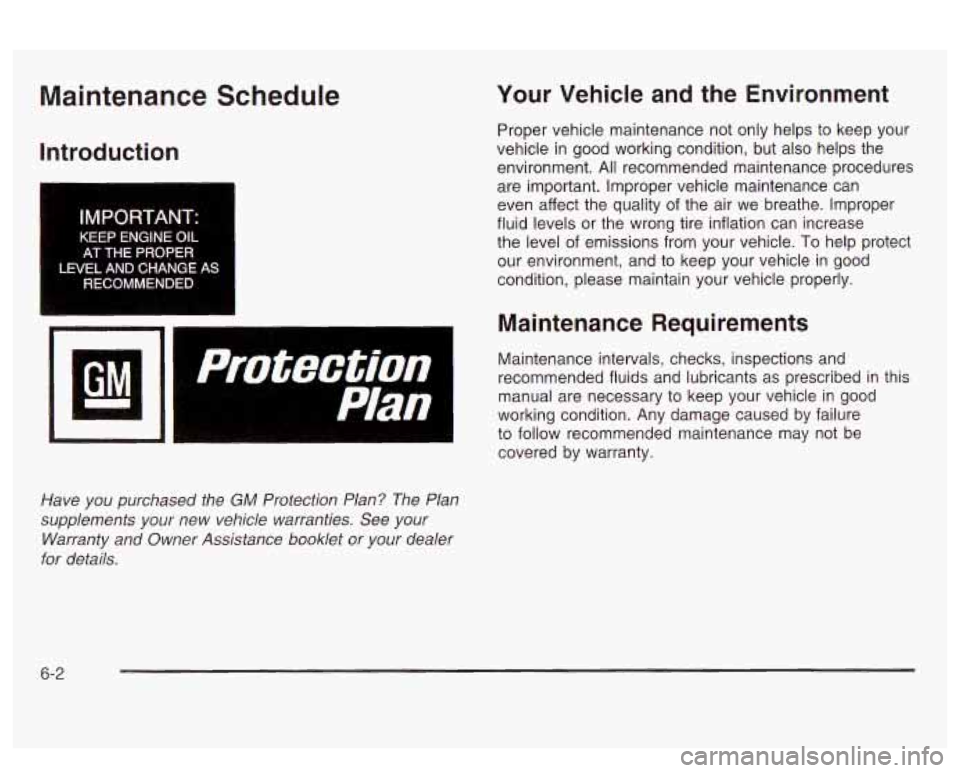
Maintenance Schedule
Introduction
IMPORTANT:
XEEP ENGINE OIL
AT THE PROPER
LEVEL AND CHANGE AS
RECOMMENDED
I
a
protection
Plan
Have you purchased the GM Protection Plan? The Plan
supplements your new vehicle warranties.
See your
Warranty and Owner Assistance booklet or your dealer
for details.
Your Vehicle and the Environment
Proper vehicle maintenance not only helps to keep your
vehicle in good working condition, but also helps the
environment.
All recommended maintenance procedures
are important. Improper vehicle maintenance can
even affect the quality of the air we breathe. Improper
fluid levels or the wrong tire inflation can increase
the level of emissions from your vehicle.
To help protect
our environment, and to keep your vehicle in good
condition, please maintain your vehicle properly.
Maintenance Requirements
Maintenance intervals, checks, inspections and
recommended fluids and lubricants as prescribed in this
manual are necessary to keep your vehicle in good
working condition. Any damage caused by failure
to follow recommended maintenance may not be
covered by warranty.
6-2
Page 364 of 418
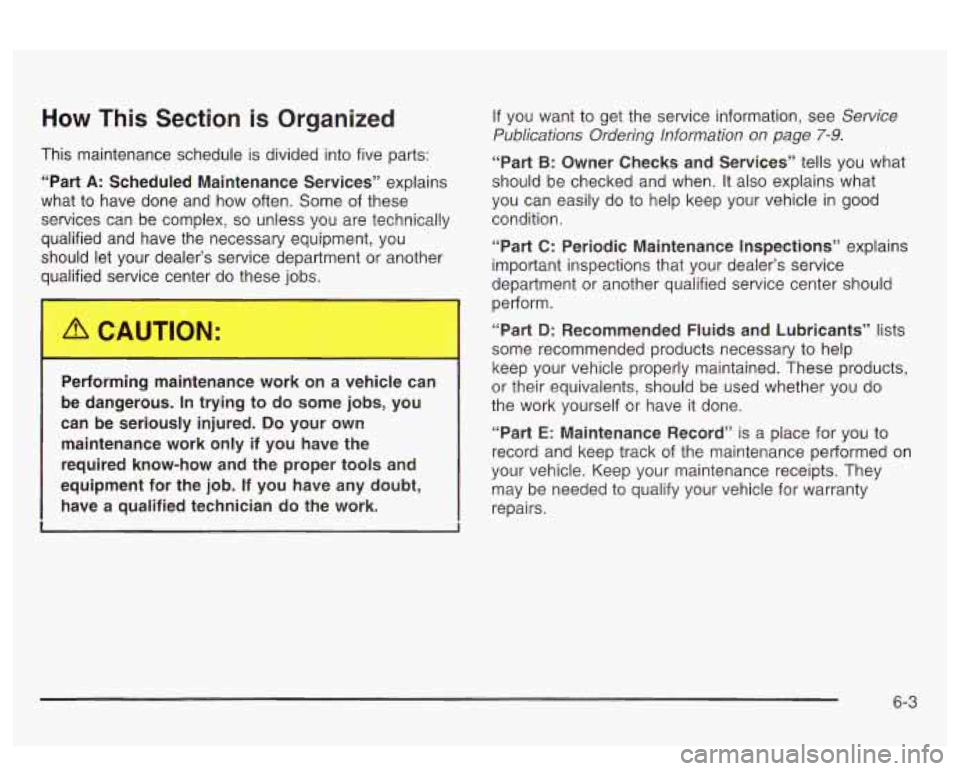
How This Section is Organized
This maintenance schedule is divided into five parts:
“Part
A: Scheduled Maintenance Services” explains
what to have done and how often. Some of these
services can be complex,
so unless you are technically
qualified and have the necessary equipment, you
should let your dealer’s service department or another
qualified service center do these jobs.
If you want to get the service information, see Service
Publications Ordering Information on page
7-9.
“Part B: Owner Checks and Services” tells you what
should be checked and when. It also explains what
you can easily do to help keep your vehicle in good
condition.
“Part C: Periodic Maintenance Inspections” explains
important inspections that your dealer’s service
department or another qualified service center should
petform.
Performing maintenance work on a vehicle can
be dangerous. In trying to do some jobs, you
can be seriously injured.
Do your own
maintenance work only if you have the
required know-how and the proper tools and
equipment for the job.
If you have any doubt,
have a qualified technician
do the work.
I
“Part D: Recommended Fluids and Lubricants” lists
some recommended products necessary
to help
keep your vehicle properly maintained. These products,
or their equivalents, should be used whether you do
the work yourself or have it done.
“Part E: Maintenance Record” is a place for you to
record and keep track of the maintenance performed on
your vehicle. Keep your maintenance receipts. They
may be needed to qualify your vehicle for warranty
repairs.
6-3
Page 365 of 418
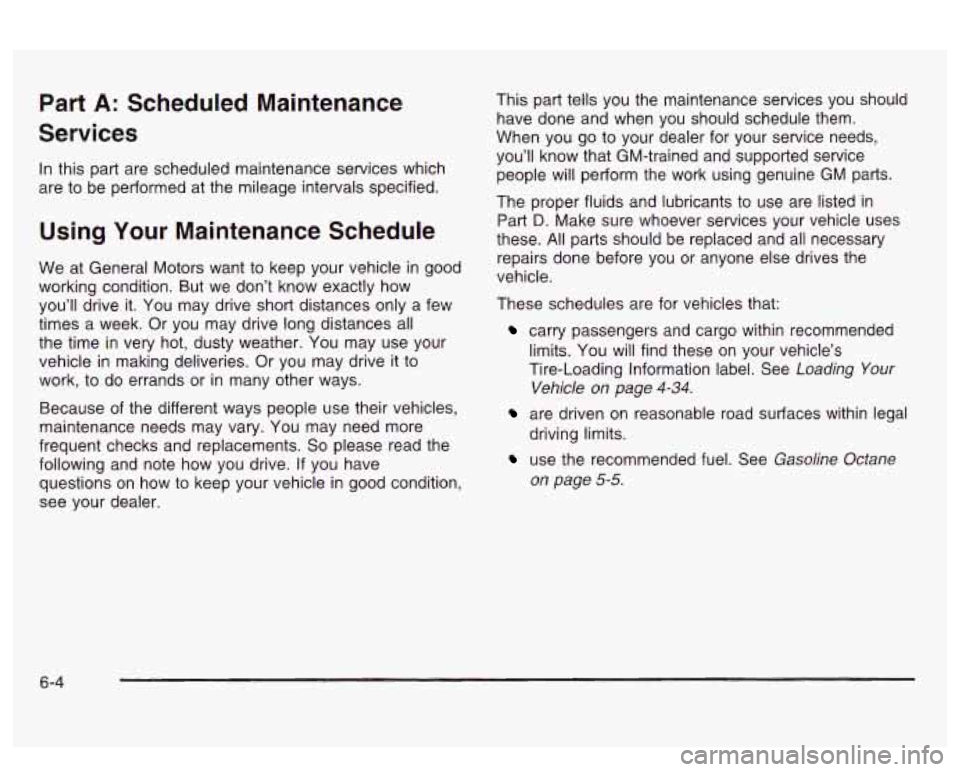
Part A: Scheduled Maintenance
Services
In this part are scheduled maintenance services which
are to be performed at the mileage intervals specified.
Using Your Maintenance Schedule
We at General Motors want to keep your vehicle in good
working condition. But we don’t know exactly how
you’ll drive it. You may drive short distances only a few
times a week. Or you may drive long distances all
the time in very hot, dusty weather. You may use your
vehicle in making deliveries. Or you may drive it to
work, to do errands or in many other ways.
Because of the different ways people use their vehicles,
maintenance needs may vary. You may need more
frequent checks and replacements. So please read the
following and note how you drive.
If you have
questions on how to keep your vehicle in good condition,
see your dealer. This part tells you the
maintenance services you should
have done and when you should schedule them.
When you go to your dealer for your service needs,
you’ll know that GM-trained and supported service
people will perform the work using genuine GM parts.
The proper fluids and lubricants to use are listed in
Part
D. Make sure whoever services your vehicle uses
these.
All parts should be replaced and all necessary
repairs done before you or anyone else drives the
vehicle.
These schedules are for vehicles that:
carry passengers and cargo within recommended
limits. You will find these on your vehicle’s
Tire-Loading Information label. See
Loading Your
Vehicle on page 4-34.
are driven on reasonable road surfaces within legal
use the recommended fuel. See Gasoline Octane
driving limits.
on page 5-5.
6-4
Page 366 of 418
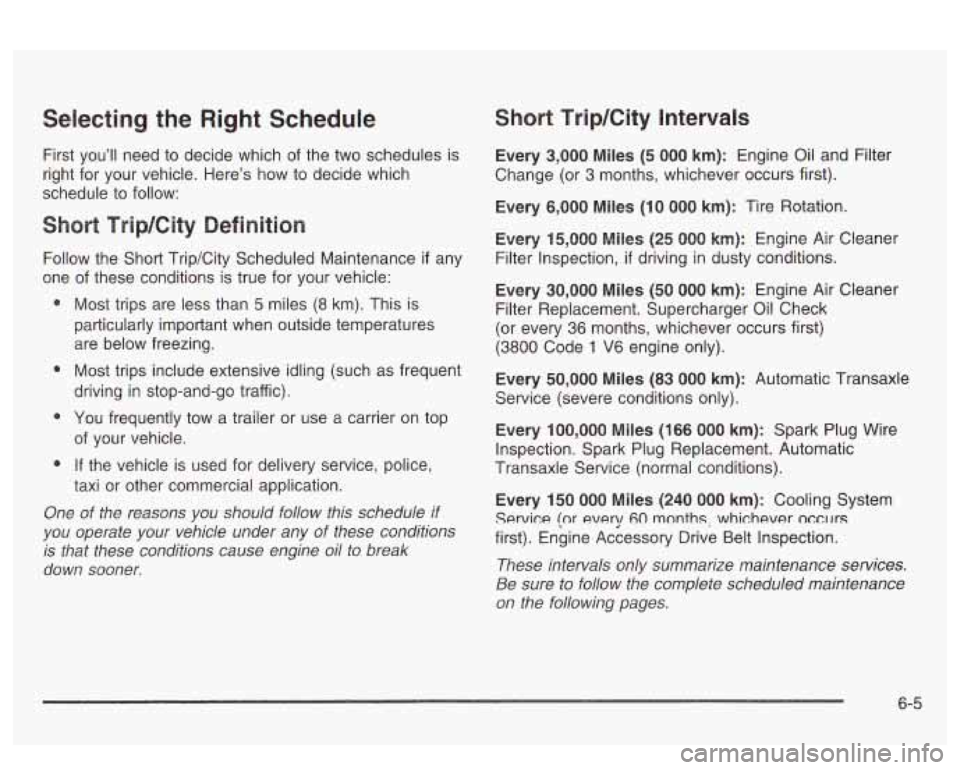
Selecting the Right Schedule
First you’ll need to decide which of the two schedules is
right for your vehicle. Here’s how to decide which
schedule to follow:
Follow the Short Trip/City Scheduled Maintenance
if any
one of these conditions is true for your vehicle:
0 Most trips are less than 5 miles (8 km). This is
particularly important when outside temperatures
are below freezing.
0 Most trips include extensive idling (such as frequent
0 You frequently tow a trailer or use a carrier on top
driving in
stop-and-go traffic).
of your vehicle.
0 If the vehicle is used for delivery service, police,
One of the reasons you should follow this schedule if
you operate your vehicle under any of these conditions
is that these conditions cause engine oil to break
down sooner.
taxi or other commercial application.
Short TriplCity Intervals
Every 3,000 Miles (5 000 km): Engine Oil and Filter
Change (or
3 months, whichever occurs first).
Every 6,000 Miles (IO 000 km): Tire Rotation.
Every 15,000 Miles (25 000 km): Engine Air Cleaner
Filter Inspection,
if driving in dusty conditions.
Every 30,000 Miles (50 000 km): Engine Air Cleaner
Filter Replacement. Supercharger Oil Check
(or every
36 months, whichever occurs first)
(3800 Code 1 V6 engine only).
Every 50,000 Miles (83 000 km): Automatic Transaxle
Service (severe conditions only).
Every 100,000 Miles (166 000 km): Spark Plug Wire
Inspection. Spark Plug Replacement. Automatic
Transaxle Service (normal conditions).
Every 150 000 Miles (240 000 km): Cooling System
Service [nr every 60 months, whichever nccIJrs
first). Engine Accessory Drive Belt Inspection.
These intervals only summarize maintenance services.
Be sure to follow the complete scheduled maintenance
on the following pages.
6-5
Page 367 of 418
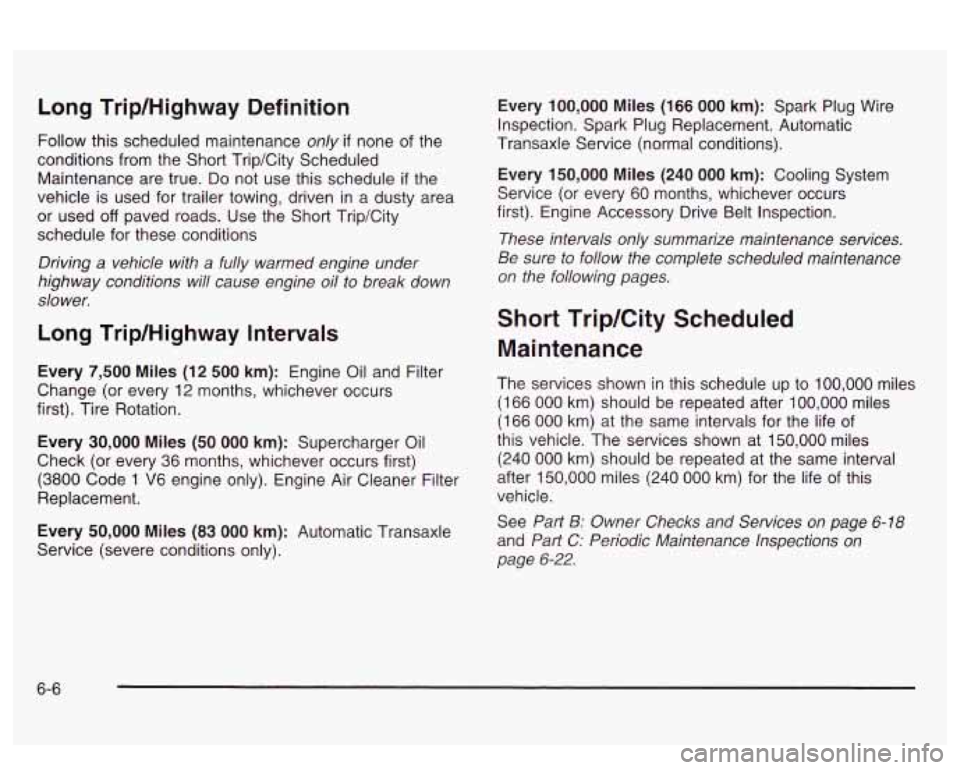
Long Trip/Highway Definition
Follow this scheduled maintenance only if none of the
conditions from the Short Trip/City Scheduled
Maintenance are true.
Do not use this schedule if the
vehicle
is used for trailer towing, driven in a dusty area
or used
off paved roads. Use the Short Trip/City
schedule for these conditions
Driving a vehicle with a fully warmed engine under
highway conditions will cause engine oil to break down
slower.
Long Trip/Highway Intervals
Every 7,500 Miles (12 500 km): Engine Oil and Filter
Change (or every 12 months, whichever occurs
first). Tire Rotation.
Every 30,000 Miles (50 000 km): Supercharger Oil
Check (or every 36 months, whichever occurs first)
(3800 Code 1 V6 engine only). Engine Air Cleaner Filter
Replacement.
Every 50,000 Miles (83 000 km): Automatic Transaxle
Service (severe conditions only).
Every 100,000 Miles (166 000 km): Spark Plug Wire
Inspection. Spark Plug Replacement. Automatic
Transaxle Service (normal conditions).
Every 150,000 Miles (240 000 km): Cooling System
Service (or every 60 months, whichever occurs
first). Engine Accessory Drive Belt Inspection.
These intervals only summarize maintenance services.
Be sure to follow the complete scheduled maintenance
on the following pages.
Short Trip/City Scheduled
Maintenance
The services shown in this schedule up to 100,000 miles
(1 66
000 km) should be repeated after 100,000 miles
(166
000 km) at the same intervals for the life of
this vehicle. The services shown at 150,000 miles
(240 000 km) should be repeated at the same interval
after 150,000 miles (240
000 km) for the life of this
vehicle.
See
Part B: Owner Checks and Services on page 6-18
and Part C: Periodic Maintenance Inspections on
page 6-22.
6-6